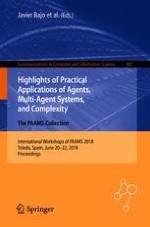2018 | Buch
Highlights of Practical Applications of Agents, Multi-Agent Systems, and Complexity: The PAAMS Collection
International Workshops of PAAMS 2018, Toledo, Spain, June 20–22, 2018, Proceedings
herausgegeben von: Javier Bajo, Juan M. Corchado, Elena María Navarro Martínez, Dr. Eneko Osaba Icedo, Philippe Mathieu, Prof. Patrycja Hoffa-Dąbrowska, Dr. Elena del Val, Sylvain Giroux, Dr. Antonio J.M. Castro, Nayat Sánchez-Pi, Vicente Julián, Dr. Ricardo Azambuja Silveira, Dr. Alberto Fernández, Rainer Unland, Prof. Rubén Fuentes-Fernández
Verlag: Springer International Publishing
Buchreihe : Communications in Computer and Information Science
